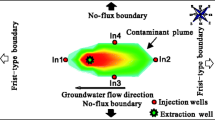Abstract
Build-up rate is a key technical parameter of the steering tools in the drilling of complex directional wells, especially sidetracked wells, lateral wells and extended-reach horizontal wells. However, prediction of build-up rate is affected by various factors and very difficult to use explicit quantitative formula to portray its accuracy. So it is necessary to seek a scientific and efficient prediction method to be directly applied in drilling those wells, to improve wellbore trajectory control accuracy and speed, reduce development costs and improve economic efficiency. Based on hot methods of drilling engineering, from a regression analysis point of view, a novel method is proposed, which uses the Kriging surrogate model to build the predictive performance function to predict the build-up rate. In order to verify the effectiveness and superiority of the method, based on one field drilling data, Kriging surrogate model and commonly used regression models which are first-order polynomial regression models and radial basis function model, are built. Their three common performance indicators, i.e., root-mean-square error, maximum absolute error and average absolute error, are calculated and compared. The results reveal that, under different types of testing samples, the prediction performance of Kriging surrogate model is superior to the other two models in the three selected indicators. As to the computational process and prediction performance, the proposed method has better prediction performance, more robust prediction results, low computational complexity and more efficiency.
Similar content being viewed by others
References
Karisson, H.; Brassfield, T.; Krueger, V.: Performance drilling optimization. Soc. Petrol Eng. J. 439-446 (1985)
Feng, D.; Wu, L.; Wang, J.W.; et al.: Research on eccentric displacement of the Trajectory Control Tool of High Build-up Rate Wellbore. Lecture Notes in Information Technology. 9, 291–296 (2012)
Lubinski, A.; Woods, H.B.: Factors affecting the angle of inclination and dog-legging in rotary bore holes. Drilling and Production Practice. 222–250 (1953)
Feng, D.; Xiao, A.; Liao, Z.J.; et al.: Loading and axial deformation of finite element analysis of down-hole strings used for hydraulic fracturing. Appl. Mech. Mater. 318, 3–6 (2013)
Zhang, H.; Feng, Y.J.; Tu, Y.L.; et al.: Research on influential factors of build-up rate and prediction method. J. Oil Gas Technol. 38(4), 80–89 (2016)
Al-Betairi, E.A.; Moussa, M.M.; Al-Otaibi, S.: Multiple regression approach to optimize drilling operations in the Arabian Gulf area. SPE Drill. Eng. 3, 83–88 (1988)
Kahraman, S.: Rotary and percussive drilling prediction using regression analysis. Int. J. Rock Mech. Min. Sci. 36, 981–989 (1999)
Kumar, B.R.; Vardhan, H.; Govindaraj, M.: Prediction of uniaxial compressive strength, tensile strength and porosity of sedimentary rocks using sound level produced during rotary drilling. Rock Mech. Rock Eng. 44, 613–620 (2011)
Kumar, B.R.; Vardhan, H.; Govindaraj, M.; et al.: Regression analysis and ANN models to predict rock properties from sound levels produced during drilling. Int. J. Rock Mech. Min. Sci. 58, 61–72 (2013)
Basarir, H.; Tutluoglu, L.; Karpuz, C.: Penetration rate prediction for diamond bit drilling by adaptive neuro-fuzzy inference system and multiple regressions. Eng. Geol. 173, 1–9 (2014)
Sepúlveda, F.; Rosenberg, M.D.; Rowland, J.V.; et al.: Kriging predictions of drill-hole stratigraphy and temperature data from the Wairakei geothermal field, New Zealand: Implications for conceptual modeling. Geothermics 42, 13–31 (2012)
Chen, Z.; Qiu, H.; Gao, L.; et al.: A local adaptive sampling method for reliability-based design optimization using Kriging model. Struct. Multidiscip. Optim. 49, 401–416 (2014)
Cressie, N.: The origins of kriging. Math. Geol. 22, 239–252 (1990)
Talgat, K.: Wellbore integrity analysis for wellpath optimization and drilling risks reduction. Degree of Master of Science (Petroleum Engineering) (2014)
Zhou, X.J.; Ma, Y.Z.; Tu, Y.L.; et al.: Ensemble of surrogates for dual response surface modeling in robust parameter design. Qual. Reliab. Eng. Int. 29, 173–197 (2013)
Wan, W.; Birch, J.B.: A semiparametric technique for the multi-response optimization problem. Qual. Reliab. Eng. Int. 27, 47–59 (2011)
Author information
Authors and Affiliations
Corresponding author
Rights and permissions
About this article
Cite this article
Zhang, H., Feng, D., Wei, S. et al. A New Predicting Method of Build-up Rate of Steering Tools Based on Kriging Surrogate Model. Arab J Sci Eng 43, 4949–4956 (2018). https://doi.org/10.1007/s13369-018-3181-7
Received:
Accepted:
Published:
Issue Date:
DOI: https://doi.org/10.1007/s13369-018-3181-7




